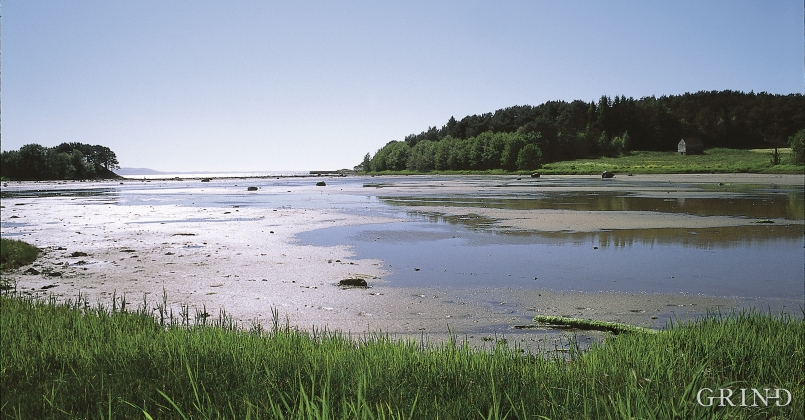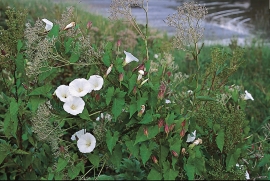Published: 29.07.2015 | Author: Inge Aarseth, Anders Lundberg, Stein Byrkjeland
ICE AGE CLAY
Bays that are shallow far out into the sea, with fine sand and clay, are rare in Hordaland. Where they are found, the reason is usually that the edge of the glacier made smaller advances or stopovers when it calved back at the end of the last Ice Age. This is what happened at Vinnesleira.
During a milder period from about 14 2000- 12 800 years ago, Bjørna Fjord and Fusa Fjord were ice-free. The clay, with shells, was deposited on what then was sea bottom, but which today is dry land at Vinnes. In the area from the lumber storage locality at Skåte and southward toward the school on Vinnes, one often finds crushed shell in the hard-packed clay. The shell was crushed when the glacier advanced about 1 500 years later and stopped a bit south of Vinnesholmen. There, it laid down an end moraine that today appears as a tongue out into the fjord (Skagen)made of big stone blocks. The moraine extends from the fishing grounds west of Hatlemnesholmen and right across the fjord all the way to Os. On the land side, it extends from the earthen hill behind the school and up toward the mountain. Silt and clay were carried by the current and deposited on the bottom in the area that now is Vinnesleira and the big lowland plain along the road to Strandvik. Drillings on this lowland plain reveal an over 27 metre-thick layer, mostly deposited when the glacier lay nearby; only the uppermost 6-7 metres are from the years following. The area here (4 metres over sea level) was dry land about 2600 years ago. Later, about 1 metre of peat has accumulated up over the clay.
During the period from 1878 -1923, there was a brick factory in operation at Vinnes. The sea was dammed up so that clay could be removed from the sea bottom. The dams, just inside of the bay where the brick factory was located, are still visible today.
Map of the Vinnes area 11 700 years ago. The terraces on Dalland (72 metres above sea level) were then a delta out into the fjord. (Inge Aarseth/Eva Bjørseth)
Platter of food for wading birds
Bird life at Vinnesleira is especially lively at low tide in the autumn, when the wading birds on their way south find a good resting spot just here. A whole 21 different species of wading birds have been documented at Vinnesleira. Dunlin,Golden Plover and the Ringed Plover are the most common. Nonetheless, you will only rarely see large flocks. This is because the locality lies somewhat isolated from the most popular migration routes, which go further out along the coast. Shells, mussels and bristleworms are believed to be the most important food for the wading birds here.
Vinnesleira lies well protected, and closely surrounded by lush vegetation. Therefore, there is also a varied bird life here in the summer, but then also including birds that are attracted to the forest nearby. Occasionally, big flocks of gulls visit the area. These are probably nesting birds from Steglholmen and Gåseskjeret - a protected bird reservation located just outside of Strandvik. The bird reservation has some of the most stable nesting colonies of Common Gulls in the county.
Vibrant nature on remnant from ice age
On Vinnesleira, there are different colonies of plants, each in its place, according to how much saltwater they tolerate. Common saltmarsh-grass grows farthest down and is continuously washed under water. In slightly shallower areas, this grass is replaced by brackish-mud rush, and thereafter by sea milkwort and sea plantain. It is the salt that keeps most plants away, and therefore the number of species increases toward land. Hedge bindweed (picture) climbs over other plants and up in trees. With its large, white flowers, it is easy to see. Black alder creates a narrow border of forest around the bay. It grows near the sea, since it tolerates having its roots in salt water for short periods.
Innermost in the bay the beach is influenced by the influx of fresh water from a stream. Here, we find tidal salt marshes with the tall plants sea club rush, chaffy sedge and canary grass. Because the clay is very compact, little air reaches down to where the plants have their roots. Without oxygen, the roots cannot carry out vital tasks, such as breathing and uptake of water and nutrients. The plants in the saltmarshes therefore have developed an air tissue that transports oxygen from the parts of the plant above ground down to the roots
- Vindenes, R. 1972. Fugleregistreringer fra Vinnesleiren, Fusa kommune. Krompen 1 (2):11–12.
- Øvstedahl, D.O.; Aarseth, I. 1975. Bryophytes from Late Weichselian sediments at Vinnes, Western Norway. Lindbergia 3:61–68.
- Aarseth, I. 1971. Glasiasjonsforløpet i Bjørnafjords området, Hordaland. Upublisert hovedoppgave, UiB.






